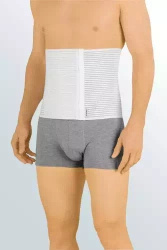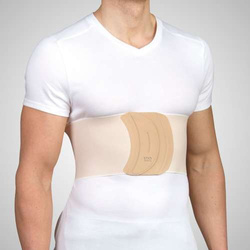Rib belts
( number of products: 14 )Rib belts for treating injuries to the chest and ribs
When it comes to treating pain caused by rib fractures or accelerating the healing process after chest surgery, nothing compares to a well-chosen rib belt. Pain caused by a broken rib should not be ignored - consulting with a specialist should be your first priority on the road to recovery.
Rib belts - who are they for?
If you have recently undergone surgery in the chest area or have a broken rib, you may experience pain during normal activities, even during breathing. In this situation, it is best that you speak with a specialist and have them select a well-fit rib brace.
These products are specially made for use, among others, during convalescence after open chest surgery, but also for treating bruised ribs and rib fractures. Rib belts are oftentimes recommended to you by a physiotherapist or a physician during screening, rehabilitation and therapy.
Their designs vary, depending on the patient’s condition, as well as gender - since men and women have anatomical differences in body structure. Most rib support products can be perfectly adapted to the figure, thus accelerating the healing process.
How do rib belts work?
As previously mentioned, rib belts are created for treating various ailments concerning the chest and ribs, such as a broken rib or fractures. They are meant to stabilize the chest and specific ribs that the given belt model covers. All straps prevent excessive stretching of the intercostal muscles and chest, thus reducing pain, maintaining postoperative sutures in good condition and prevent the straining of damaged areas.
Depending on its length and construction, the rib belt can support either the lower ribs or the entire chest, and some models also cover the abdominal area. Ask your physiotherapist or doctor for advice when adjusting the belt to help treat your ailments, injuries or surgeries. Adjusting it without their supervision might cause additional pain and damage.
A rib belt is used primarily to reduce pain, stabilize the chest area and to accelerate the recovery process and should be worn according to your physiotherapist’s or doctor’s recommendation.
What types of rib belts are available?
There are a number rib belts with various designs and are created from different materials, depending on the ailments they are meant to treat. Rib support belts can be made of inelastic and stretchable fabrics, and in some models, these two materials are combined to create a belt with a rigid front and flexible rear part. This specific model is made for treating fractured ribs.
These products are specially made to fit the chest of both male and female patients, making it easy to choose the right rib brace for everyday wear. Soft linings prevent irritation and damage to the epidermis, while high-quality fabrics guarantee proper stabilization of the entire body.
Most belts are designed to be worn on a daily basis, like during normal activities and work, and rest assured, they’re invisible under clothes. What's more, the thin material they’re made out of also provides plenty of air circulation to the skin, which makes wearing the belt even at higher temperatures comfortable.
Frequently asked questions (FAQ)
Can I sleep while wearing my rib brace?
Whether ribbed belts can be worn during sleep is often decided based on their type and the condition they’re meant to treat. In the case of post chest surgery, it may be advised to wear a rib belt at the waist to keep the stitches from loosening due to involuntary movement during sleep. With minor injuries, such as bruised ribs, it is often advised not to wear a belt to sleep, as it may weaken the muscles surrounding the rib cage. For this reason, it is best to consult with the physiotherapist conducting the rehabilitation process.














